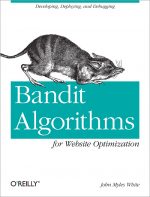Here in Part 2 of the Weekly Brief, we offer some tools to help you with the question, “what is the optimal set of alternatives to offer consumers?”
Our course spotlight is on:
- Aug 30 – Sep 27: Discrete Choice Modeling and Conjoint Analysis
See you in class!
– Peter Bruce,
Chief Academic Officer, Author, Instructor, and Founder
The Institute for Statistics Education at Statistics.com
Word of the Week
Intervals (confidence, prediction and tolerance)
All students of statistics encounter confidence intervals. Confidence intervals tell you, roughly, the interval within which you can be, say, 95% confident that the true value of some sample statistic lies. This is not the precise technical definition, but […]
 Book Review
Book Review
Bandit Algorithms for Website Optimization by John Myles White
A classic statistical experimental design comparing treatments (two treatments, treatment versus control, multiple treatments) specifies a sample size, collection of data, then a decision, typically based on hypothesis-testing: the winning treatment must […]
Job Spotlight
Amazon
What’s it like to work at Amazon? Several years ago the New York Times published this unflattering portrait of a demanding and often idiosyncratic Darwinian work culture. Because it is an operating retail firm with a huge delivery infrastructure, most Amazon employees fall into the blue-collar category. A depiction of a single Amazon culture may not be adequate to account for both the data science “priesthood” and the operations workers.
What does Amazon itself say? This official Amazon blog speaks to the interview process, both for general white-collar roles and more technical roles. Two points stand out:
- No Powerpoints. Amazonians write and read short, well-written memos prior to meetings.
- Technical candidates do not need to be able to write their own operating system from scratch (whew!)
Course Spotlight
Aug 30 – Sep 27: Discrete Choice Modeling and Conjoint Analysis
Bandit algorithms (see above book review) are one effort to get around the limits of traditional statistical comparison tests, when decisions must be taken at scale, automatically. Discrete choice modeling is another such effort, used when the decision to be made is of limited scale and concerns product attributes. Complexity enters the picture because the ultimate decision concerns not a single best set of product attributes, but rather the best set of alternatives to offer consumers. There are many such alternatives – for example in wireless service you could have alternate options for price per month, price per additional line, length of contract, phone trade-in, data included, data speed, cost of additional data, throttling, international pricing, etc. Companies want to present consumers with a limited set of choices to facilitate decision-making; the question is “what is the optimal set of alternatives?”
Your instructor is Anthony Babinec, President of AB Analytics and expert in the application of advanced statistical methods to consumer decision-making. You will learn how to:
- Use designed experiments to collect data on how consumers view product choices
- Use that data to derive models on how attributes affect consumer preference
- Use a final model to predict how the market would choose among sets of product options
See you in class!
Contact Us To Register or Learn More
If you have any questions on our courses, certificates, and degree programs and how they can apply to you, your work, and to your career, please get in touch. We’re here to help you succeed.

 Book Review
Book Review